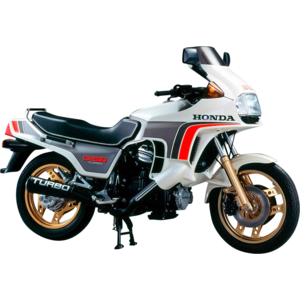Honda CX 500 Turbo (1982–1985): A Turbocharged Relic That Still Thrills
Introduction
The Honda CX 500 Turbo is a motorcycle that defies expectations. Born in an era when turbocharging was the automotive industry’s answer to emissions regulations and power cravings, this bike stands as a fascinating relic of 1980s engineering ambition. With its futuristic looks, oddball engine configuration, and a turbocharger strapped to a V-twin, the CX500 Turbo remains a cult classic. But how does it hold up today? After a spirited test ride, it’s clear this machine is more than a novelty—it’s a time capsule that still delivers grins.
Design & Styling: A Love-It-or-Hate-It Proposition
The CX500 Turbo’s design is unmistakably ’80s. Its angular fairing, boxy tail section, and chunky gauges scream retro-futurism. The cockpit features a digital speedometer (a rarity in its day) flanked by analog gauges for the tachometer and turbo boost pressure—a nod to its performance aspirations. The fairing integrates a rectangular headlight and vents to cool the turbo, while the stepped seat and upright riding position prioritize comfort over sportiness.
Love it or hate it, the Turbo’s design has aged into a quirky charm. The glossy paint schemes—often in bold red or silver—still pop, and the turbine-inspired wheels add a touch of aerospace flair. Compared to the standard CX500’s utilitarian looks, the Turbo feels like a spaceship.
Engine & Performance: Boosted Character
The Heart of the Matter
At its core lies a 496cc (30.3 cubic inches), liquid-cooled 80-degree V-twin—a layout Honda chose for compactness and smoothness. But the star of the show is the Mitsubishi TC03 turbocharger, force-feeding the engine up to 14.5 psi of boost. The result? 82 PS (60 kW / 81 hp) at 8,000 RPM and 62 Nm (46 lb-ft) of torque. For 1982, these numbers were impressive, putting it on par with 750cc rivals.
Riding the Boost Wave
Throttle response is… interesting. Below 4,000 RPM, the engine feels asthmatic, chugging like a commuter bike. But once the turbo spools—whoosh—the CX500 transforms. The surge of acceleration is addictive, pushing the 262 kg (578 lb) bike forward with a muffled whine from the turbo. It’s not seamless by modern standards—turbo lag is pronounced—but the raw, mechanical feel is part of its charm.
Top speed sits around 200 km/h (124 mph), though reaching it requires patience as the aerodynamics (read: brick-like fairing) fight you. Fuel economy? Expect 6.5–7.5 L/100 km (36–31 MPG) if you’re gentle, but good luck resisting the boost.
Riding Experience: Oddly Rewarding
On the Road
The CX500 Turbo’s riding position is relaxed, with wide handlebars and a plush seat. The suspension—37mm telescopic forks (280ml SAE 10W oil) up front and dual shocks—is tuned for comfort, soaking up bumps but wallowing in corners. Braking is adequate, with a single disc up front and drum rear, though modern riders might crave more bite.
The shaft drive eliminates chain maintenance but adds weight. In corners, the bike feels top-heavy, demanding deliberate input. Yet, once leaned over, it holds a line surprisingly well. The Bridgestone tires (original specs: 1.8–2.0 bar front [26–29 psi], 2.0 bar rear [29 psi]) offer decent grip, though upgrading to modern rubber would transform handling.
Quirks & Features
- Turbo Sounds: The whistling spool and blow-off valve chirps are pure ’80s ASMR.
- Heat Management: The turbo cooks your legs in traffic—wear thick pants.
- Vibration: The V-twin buzzes at highway speeds, but it’s less intrusive than expected.
Competition: Turbo Wars of the ’80s
The CX500 Turbo entered a short-lived turbocharged arms race. Key rivals:
1. Yamaha XJ650 Seca Turbo (1982–1983)
Yamaha’s inline-four turbo made 85 hp and felt smoother at high RPMs. However, its chain drive required more maintenance, and the styling lacked the Honda’s boldness. The Seca Turbo was faster but less charismatic.
2. Kawasaki GPz750 Turbo (1984–1985)
The GPz was a brute, with 112 hp from its 738cc inline-four. It dominated straight-line speed but suffered from brutal turbo lag and a punishing riding position. The Honda’s V-twin offered better low-end usability.
3. Suzuki XN85 Turbo (1983–1985)
Suzuki’s 673cc inline-four turbo was lighter and nimbler but plagued by reliability issues. The CX500’s shaft drive and Honda build quality aged better.
Verdict: The CX500 Turbo wasn’t the fastest or most refined, but its unique engine, low-maintenance shaft drive, and avant-garde design make it the most memorable today.
Maintenance: Keeping the Turbo Alive
Key Considerations
- Turbocharger Care:
- Let the engine idle for 1–2 minutes after hard rides to cool the turbo.
-
Check for oil leaks around the turbo bearings. Use SAE 10W-40 oil (3.5L with filter) meeting API SE specs.
-
Valve Adjustments:
- Intake: 0.08 mm (0.0031 in) / Exhaust: 0.10 mm (0.0039 in) cold.
-
The shim-under-bucket design requires patience—budget 3–4 hours for this job.
-
Cooling System:
-
Replace coolant every 2 years (2.1L capacity). Watch for corrosion in the V-twin’s tight cooling passages.
-
Shaft Drive:
-
Inspect the final drive oil (170ml SAE 90 GL-5) annually. Noisy? Check the universal joint.
-
Brakes:
- Upgrade to DOT 4 fluid for better heat resistance. The single front disc benefits from sintered pads.
MOTOPARTS.store Recommendations
- NGK DPR8EIX-9 Iridium Plugs: Handle turbo heat better than stock.
- Upgraded Suspension: Modern fork oil (SAE 10W) and aftermarket shocks improve ride quality.
- Turbo Timer Kits: Protect your turbo with an automatic cooldown system.
Conclusion: A Timeless Oddity
The Honda CX500 Turbo is a motorcycle that shouldn’t work—a turbocharged, V-twin, shaft-driven experiment. Yet, 40 years later, it’s a riot to ride. Its quirks are its personality, and its flaws are forgiven by sheer audacity. For owners, maintaining this piece of history is a labor of love, but with MOTOPARTS.store’s catalog of upgrades and OEM-spec components, keeping the boost alive has never been easier.
Whether you’re chasing nostalgia or hunting for a conversation starter, the CX500 Turbo delivers. Just don’t forget to let it cool down.
Revive your CX500 Turbo with performance parts and expert advice at MOTOPARTS.store—where classic bikes meet modern reliability.



















